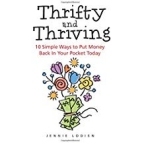Thrifty & Thriving

Trevor here, I hope you’re well.
The idea of being thrifty isn’t something we see much of these days. Speaking for myself, I’ve never been the thrifty sort and that has caused me some issues over the years.

However, that is definitely changing now, especially since I got a copy of a new book by a fellow Chris Payne student Jennie Lodien. Jennie has been a master of living thriftily throughout her life and her book, Thrifty and Thriving, outlines 10 simple ways to put money in back in your pocket today.
There are some very interesting insights in this book into why we tend not to be as thrifty as we could be. I found her analysis of why we spend money on things we don’t really need to be very useful in understanding why I’ve tended to spend when I didn’t need to.
Let me say straight away that this book isn’t about being a scrooge, or about hoarding money in a tin box under the bed while we starve.
What it is about is spending less on things that we don’t need so we can spend more on the things we do. It’s more about postponing immediate pleasure in return for a greater pleasure later on.
I learned things about us as humans from this book that I didn’t know before that will help me and I think many of my students and clients trying to make a go of this marketing online thing.
One of the results of research that she highlights is that we tend to make purchases based on what we will earn in the future.
In our personal life many of us will buy a new TV or car or other quite expensive purchase based on our future income over the coming few years that we spread the finance over.
We usually take on a hire purchase agreement to pay for the item over 3 or more years.
What this does is reduce the amount of disposable money we have to spend on other things and cost us more because of the interest we have to pay.
Another interesting piece of her research showed that we get more pleasure from the anticipation of a purchase than we do from actually getting the item.
It appears that immediately we own the item our level of pleasure diminishes very quickly. Researchers call this ‘Hedonic Decline’ where happy feelings dissipate and we’re left wanting more.
Taking this example and applying it to making purchases of IM products online I see the same thing happening. This I believe is the basis of much of the shiney object syndrome buying frenzy that we see.
That buying habit also ties in well with the concept that we buy based on future income.
Have you had times when you’ve been on a webinar. The webinar presenter pitches a high ticket item, the cost of which is beyond money you readily have available in you bank but you decide to put it on a credit card because you will make back the purchase cost in just a few weeks – or so the webinar presenter convinces you that you will.
Hands up, I certainly have.
But then what happens after the purchase?
The satisfaction of buying declines and we quickly become less inclined to put the effort in to make the purchase price back.
I for one will be looking out for that happening in the future. Many of us have all we need to run our businesses without having to buy the latest piece of software.
This is a very interesting book that provides many valuable lessons both for our personal and business life. The book is available on Amazon and well worth getting.
OK, that’s it for this week.
I hope you find this helpful in your business.
Have a GREAT Sunday,
Until next time,
Kindest Regards,


